
| Bry's DVD Review
All About Pan and Scan
Anamorphic Widescreen? Bryan's DVD Review FAQ Bryan's Other Sites DVD
/ Movie Sites |
|
What's the difference? There is a lot of confusion over what these terms mean, and they often get misused. "Full Screen" is often used by DVD manufacturers to denote that a widescreen film has been modified to fill the shape of a standard television screen. This shape is often described as a ratio of width to height - 4:3 (aka 1.33:1). I want to note here that the purpose of this article is to inform people of the various ways of making movies fit on TV screens, and to clear up some common misconceptions. It's not about preaching the virtues of maintaining the director's original vision. 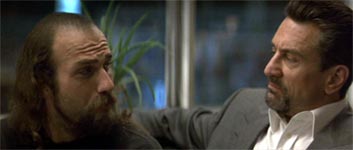 The DVD manufacturers have given consumers a somewhat simplified explanation of the difference between the widescreen and full screen versions by stating that the "modified for your tv" version shows you less information than the original widescreen version by cutting off the sides of the original image -- this is not always the case. Did you know that sometimes, the full screen version of a film actually shows more of the image than the widescreen version? "Pan and Scan" is a term people sometimes mistakenly use to describe these "modified for your tv" full screen versions -- but not all full screen versions of movies are "pan and scan"! There is more than one way to make a widescreen movie, and there is more than one way to take a widescreen movie and make it fit on a standard television. Pan and Scan is just one of those methods. A lot of the process of deciding which system to use is dependent upon how the film was originally shot, so I have broken down this guide to represent that. The two most popular film aspect ratios used in American film today are 2.35:1 (also called "Panavision" or "scope"), and 1.85:1 (also called "academy flat"). The processes for shooting films in these aspect ratios are different, and so are the methods of modifying them for television.
Pan and Scan on movies shot in Panavision/Scope Movies shot in "scope" have an aspect ratio of approximately 2.35:1. Below is a shot of Robert DeNiro from Heat (1995), in it's original aspect ratio.

In the "scope" method of shooting, the film stock itself still has the standard 1.33:1 aspect ratio -- the same shape as a standard television screen. In order to capture the wide image in a standard frame, a special lens called an "anamorphic" lens squeezes the widescreen image into a 1.33:1 frame. Below is a simulated example of what this frame would look like on the actual film:

Notice that on film the image looks compressed. Normally, you would never see a film presented this way. When you see this movie in a theater, the projector is fitted with another anamorphic lens that unsqueezes the image so that it will look normal on the screen. In order to make this wide image look normal on a television screen (which does not have the same shape as a scope film), only some of the image can be shown at once. The method most often used to modify 2.35:1 aspect ratio films to television is "Pan and Scan". The red box below shows what portion of the widescreen image you might see in a pan and scan version of this film. Notice how the character Waingro is completely out of the box. I guess he wasn't as important as Robert DeNiro in this shot.

The reason why it's called "pan and scan" is because the little window we see moves back and forth (ie pans and scans) the widescreen frame to show is the most "important" parts of the frame. For example, if these two guys are talking in this shot, the little window we are looking through moves back and forth across the widescreen frame to show us the face of who is talking. Below is an example of what the finished product might look like.
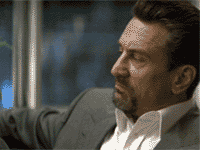
So what we are left with is an image that fits on a standard TV, and while functional for showing us the faces of the people who are talking, it clearly lacks the composition of the director's original vision. The panning action can sometimes be very distracting, and that's why many people push for the "letterbox" format, but that's an entirely different discussion!
Full frame on movies shot in Academy Flat The other most popular widescreen aspect ratio in American film is 1.85:1, aka "Academy flat." Below is a shot from Back to the Future (1985) in its originally intended aspect ratio. You'll notice that it is not as wide as the Scope movie above.
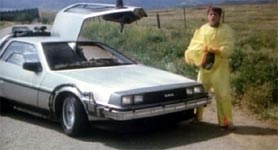
It's called "flat" because it does not use an anamorphic lens to do any squeezing. The image as it appears on film is more or less how it will appear when projected on screen. Below is an example of what this shot might look like on the actual film.

As was the case before, the aspect ratio of the actual film itself is 1.33:1, the same as a standard television. You'll notice that on film, there is actually more image above and below the intended frame. You see more of the mountain above the top of the Delorean's door, and more of the street below the car's bumper, but we were really only intended to see the part in the middle.
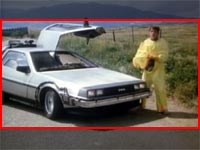
When you watch this movie in a theater, the only part within the red box is shown. This is how the director meant it to be seen, and this is how the director composed his shots. But the convenient thing is that what is actually on the film is already the same shape as your TV, so rather than go through an elaborate pan and scan process, they can just go ahead and show you the "full frame" of film, including the parts that you were not originally meant to be seeing. Below is what you get on a "modified to fit your TV" version of Back to the Future.
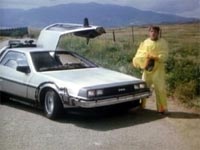
The popular belief is that "modified for tv" versions of movies show less of the image than the widescreen version, but as you can see, this method actually shows you more of the image than you were supposed to be seeing, not less! But more is not necessarily better -- as I mentioned before, the director set up all the shots to look good with the top and bottom cut off. Full Frame is not the director's "original vision", but it's a quick and easy way of modifying a widescreen film to fit on your TV. This method does not work on all 1.85:1 movies. Sometimes when looking at the full frame of film, things like microphone booms or camera equipment or crew people appear in those parts of the frame you weren't supposed to be seeing -- the part that was supposed to be cut out when viewed at the theater. In those cases, the pan and scan method must be used, since the image beyond the intended border of the widescreen frame is not really usable. A sort of nifty thing about this full frame method of modifying a movie is if you are one of the lucky few that owns a widescreen TV and you happen to be watching a movie (either on DVD, VHS or even broadcast TV) that was modified for TV using this specific method of displaying the full frame, you can actually get pretty close to the original director's vision by using the "zoom" mode on your TV, which effectively crops off the top and the bottom of the frame, just as they would have done at the movie theater.
Super35 Super 35 is a relatively new format that is sort of a hybrid between the previous methods shown above. The material is shot "flat" (without an anamorphic lens), but it is framed with both widescreen (for theatrical release) and standard (for television) aspect ratios in mind. The following images are from the Terminator 2 Ultimate Edition DVD, and demonstrate how the format works.  The scene is shot filling the entire frame of film but for the theatrical release, only the portion highlighted in blue is shown, while in the video/TV release, only the part within the red rectangle is shown, and there are some parts of the film which will never be seen. Furthermore, for the video/TV release, the red box actually pans and scans across the frame to emphasize certain parts of the image.  This is the part of the film you'd see in the theater. I must apologize for the poor quality of this particular image, but I had to enlarge it from a small shot from the DVD. 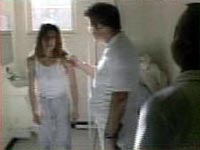 This is the part of the film you'd see on the pan and scan version for TV and video. As you can see, while this version has a shape that would fit on a TV screen, and does not show as much on the left and right side of the image, it shows more on the top and bottom when compared to the widescreen version, and again, this view would pan and scan from left to right to highlight certain parts of the frame. The advantage to this type of system is that the director can see beforehand what the movie will look like when modified for TV, and can plan for it ahead of time, and even frame the shots specifically for it. The disadvantage to this type of system is that by using so little of the actual frame of film in the final product, the picture is not as sharp as it is with other methods of shooting widescreen. Some directors, like James Cameron, say that they actually prefer the pan and scan version of their Super35 films... which puts them at odds with hardcore widescreen movie enthusiasts.
Conclusion Ok, I lied, I said I wasn't going to preach about widescreen being better. All I can say is that ideally, we'd all be watching these movies as the director intended us to, which usually means on film, projected on a sweeping wide screen. But the fact of the matter is, most people at home have to settle for a TV at home, and most of those TV's are not widescreen. So we have to compromise, and neither of these methods of modifying a widescreen film for TV are ideal. In come the purists saying that the letterboxed widescreen versions in the original aspect ratio are the ideal way to see a movie, and preserving the original vision of the director is of paramount importance. But let's face reality -- sometimes when trying to watch movies on standard TVs in the original aspect ratio, (preserving the original 'vision'), the "black bars" used to letterbox the movie can take over as much as half of the screen (especially on 2.35:1 and wider films), leaving the actual image so tiny you can hardly see what's going on. This is hardly ideal. I personally am one of those lucky few that have a widescreen TV, so the compromises I have to make to watch widescreen movies are not as great as they are for people with standard television sets, and as much as possible I try to watch movies in their original aspect ratio. On the other hand, every time I try to watch a regular 1.33:1 television broadcast on my widescreen TV, it's always a compromise. But this too is a whole other discussion. But again, the real reason behind this article is to dispell some of the misconceptions about how movies are modified for television, particularly the notion that the modified versions always show less than the original widescreen version. I hope it was interesting and informative for you! If you have any questions, comments or corrections, feel free to send me e-mail. And if you're Warner Brothers or Universal, please don't sue me for using images from your fine films for this little demonstration!
|

